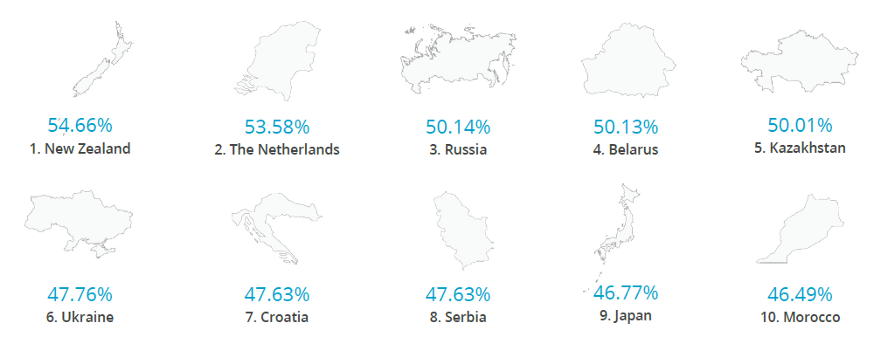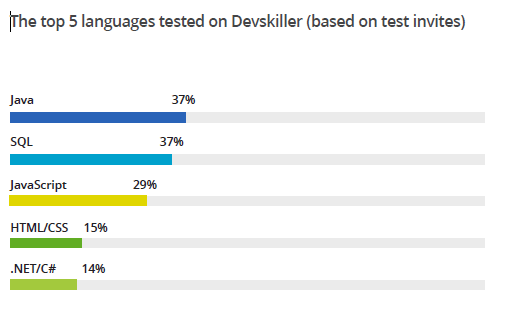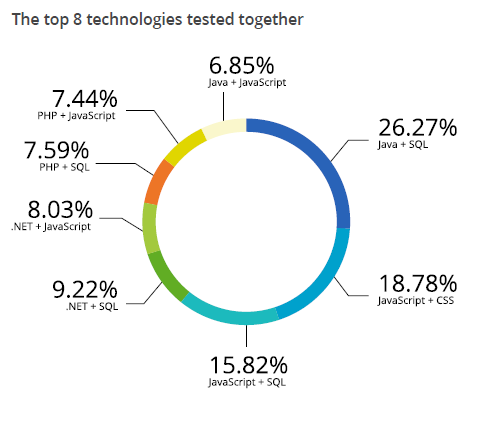Analysis of 112654 test items and trends in the labor market of programmers in 2019
- Transfer
The material, the translation of which we publish today, is devoted to the analysis of the labor market of software developers. Namely, the company Devskiller , which works in the field of recruiting, is divided here the result of the study of 112,654 test tasks that programmers performed. It will talk about the countries in which the programmers live, the best tested, where are the companies that hire the most overseas employees, and which groups of technologies are most in demand in the labor market.

Information is the most important thing in the selection of programmer personnel. This is true for employers and for those who are looking for work. If someone, being engaged in recruiting, understands the trends of the IT industry, is aware of what knowledge and skills are in demand in the labor market, knows where programmers live, who are hired, it will be easier for him to bring together suitable programmers and the company that is looking for a working force
Devskiller is studying the problem of finding a job in a technical environment. The most important part of such research is the data on the hiring of programmers. But, working in this area, the company faced one problem.
The point is that what can be called “trends in hiring programmers” can be described using innumerable parameters. The challenge for Devskiller is to understand exactly what information is truly useful.
For example, surveys conducted among participants in the employee search process imply a fair amount of subjectivity. But the importance of the correct solution of the task of finding a job or employee, both from the point of view of the applicant and from the point of view of the employer, requires more reliable data. In Devskiller believed that way, so we decided to look at the data they already have.
Namely, this company helps employers look for programmers. The employer may offer the applicant to pass a test on a certain set of technologies by creating a task and sending an invitation to the applicant to pass it. The test may consist of several tasks. For example, it may include a test with the need to select answers to questions, and a practical task, which is to find and correct an error in a certain software project.
Last year, Devskiller scored 112,654 results of such tests. The company believes that such data, supplied with additional information, is the most valuable source of information about the labor market. Actions always speak louder than words. Namely, we are talking about the fact that the test data objectively reflects what knowledge and skills of the company are expected from potential employees, and exactly where, in terms of geographic location, they are looking for labor.
And the data in question is not something of a technological forecast. These data are based on clearly formulated company requirements for potential employees.
We will talk about what we managed to find out by analyzing the results of the test tasks performed by programmers and studying some other information about them and about companies that are looking for new employees.
As it turned out, the best test result (54.66%) is shown by programmers from New Zealand.
The author of the material notes that the spirit of healthy competition lives in the programmer environment. Programmers are constantly looking for ways to compare what they know and can do with the knowledge and skills of other programmers. Such comparisons can take an international character and reflect how programmers perceive their level of education and professionalism.
Thus, candidates from more than 120 countries participated in the trials. If we compare the results of passing tests by programmers from different countries, it turns out that New Zealand is in first place here (54.66%), the Netherlands is in second place (53.58%), and programmers from Russia are in third place (50.14%). But this is how the first ten countries in which programmers live, best of all coping with tests, look like.

The average score of programmers from different countries
What can cause such results? Maybe it lies in the features of the educational systems of different countries? Or, perhaps, developers from some countries just got easier tasks? Perhaps the reason for what is happening can be considered the fact that New Zealand is making great efforts to attract foreign highly qualified specialists to the country. They could have influenced the fact that the country took the first place in this rating.
This raises another question. Are the developers from the countries with the highest results also the nominal labor force that companies in other countries are looking for?
As it turned out, more than 30% of foreign candidates tested companies located in the United States. At the same time, in the share of the total number of programmers tested by such companies, foreign ones constitute only 40%. In addition, the United States is in second place in the ranking of countries-exporters of labor.
Such results probably should not look completely unexpected, given the size of the US technology sector. In addition, this country is known for the high salaries of programmers, which is one of the factors attracting the best specialists to the country. This is how the top five countries look like; companies located in which are most actively looking for foreign programmers.

Countries, companies located in which, looking for foreign specialists
Quite interesting data are obtained when comparing countries-exporters of labor. Here the first place is occupied by India. There are more than a quarter of programmers who have been tested on the Devskiller platform.

Exporters of labor force
It is interesting that the United States ranks second in this ranking. As a result, it turns out that this country is in a rather curious position. On the one hand, US companies are most actively looking for foreign labor, on the other hand, there are a lot of programmers in this country who are looking for work abroad.
This indicates a strong trend towards the internationalization of the labor market of programmers. Perhaps this leads to higher labor efficiency, as companies can attract programmers with exactly the knowledge and skills that these companies need, regardless of where these programmers live.
Here it can be noted that programmers from the United States readily agree to work abroad, in companies that need their knowledge and skills.
But what is this knowledge? What kind of specialists are looking for companies? What technologies are most popular today?
As it turned out, 70% of companies are looking for JavaScript developers. At the same time, there is constant talk of what will become the next great phenomenon in the IT world. But it should be noted that, in reasoning about the rise of Kotlin or about the possible capture of the world by the Golang language, it is easy to forget that these and many other technologies are still in the stage of growth and development.
In most organizations, mature, well-established, advanced technologies like JavaScript continue to be in serious demand. As a matter of fact, this statement is confirmed by the above-mentioned data on JavaScript. Here is a list of 5 technologies that specialists who own are needed by the largest number of companies.

The most popular technologies
It will be interesting to compare these indicators with indicators based on what tests employers offer to pass to applicants. First place here is Java.

Technologies whose knowledge tests are offered to applicants
According to the results of the research, it can be concluded that JavaScript is suitable for solving problems of various scales, a lot of companies of various sizes are interested in JS knowledge. Java, on the other hand, better meets the needs of large teams; moreover, such needs arise in fewer companies.
But if we talk about the different needs of companies, then most of all they differ not in the scale of whole technology stacks, but in the scale of a separate stack.
Although 70% of companies are interested in JavaScript-programmers, the most interesting is manifested in a more careful analysis of this figure. It turns out that different companies are interested in different libraries or frameworks. Developers experience, as a rule, not something like “knowledge of pure JavaScript”, but possession of something like React, Angular, Vue, Node.js.
We would advise anyone who wants to find work in the framework of a certain technology, not to expect that the employer would be interested solely in how he knows the language underlying this technology. Companies are interested not in knowledge of the basic language, but in possession of a set of technologies associated with it. At the same time, it should be noted that employers are focused on checking possession of a certain stack of technologies not only when testing JavaScript programmers.
Namely, we are talking about the fact that employers are interested in specific areas of application of programming languages. For example, if you are positioning yourself as a Java specialist, be prepared to go through Spring or Android development tests.
If you go back to JavaScript, then in this area, skills such as React, Angular, jQuery, Node.js, Ember may be subjected to tests.
Database developers can expect tests in MySQL, PostgreSQL or HSQLDB.
PHP-programmers can be offered tasks for Laravel or Symphony.
And those who write in Python can get jobs depending on the specific position where they have to show the ability to work with Django, Pandas or Numpy.

Technology Stacks
From all this, one important conclusion can be made. A modern programmer does not have enough deep knowledge of a certain language. In the labor market, the ability to work with a specific technology stack is valued, and it is the specialists who demonstrate this ability and are looking for companies.
All this suggests that a programmer who wants to find a good job needs to know not only a certain programming language, but also be able to use various libraries and frameworks associated with this language.
It turned out that the skills in server development and in the field of working with databases are often tested together.
Of course, for some positions it may be quite enough knowledge within a single stack of technologies. But more and more often, programmers are offered to demonstrate the ability to use stacks of technologies that complement each other. This raises the question of which technologies complement each other.
In the overwhelming majority of cases we are talking about the development of server applications and the ability to work with databases. Here we denote database technology as “SQL”.
Among the eight combinations of technologies, the possession of which most often interests employers, 26% were a combination of Java and SQL. In addition, the combination of .NET and SQL owns 9%.
The combination of JavaScript, which, thanks to Node.js, now applies to server languages and SQL, employers are interested in 15% of cases. Finally, knowledge of PHP and SQL is explored in about 7% of cases.

Combinations of technologies that employers are interested in.
It is interesting to note that when it comes to front-end development, JavaScript is often tested along with the ability to use CSS. It is about 18% of cases. If we consider other popular combinations of technologies, it turns out that combinations of .NET and JavaScript are given 8% of the tests, PHP and JavaScript are combined in 7% of cases, Java and JavaScript - in 6% of tests.
From this we can conclude that if you are a backend developer, then knowledge of working with databases is also important to you. Similarly, if you are a full-developer developer, then no matter what you write the server code, you will have to use JavaScript to develop the frontend.
Here we talked a lot about the tests that company programmers are looking for employees. In the end, it is on the data of such tests that our research is built. But in certain circles, such things are perceived ambiguously.
Typically, test assignments are criticized for taking too long, for being very weakly connected with real work, and for the fact that the programmer, while performing tasks, cannot fully demonstrate his capabilities. Some programmers even claim that if they are offered a certain task during the job search, they will not do it and give up the potential workplace.
In this regard, it is interesting to note that 73% of the total number of developers who, in the process of testing before hiring, were offered to perform our tasks, perform these tasks. This indicates that with the correct selection of tasks, if the tasks are related to reality, a considerable number of applicants perform these tasks. As a result, the employer receives important and relevant information about their knowledge and skills.
We have already said that in different countries the average level of training of developers varies. A similar trend concerns the intelligibility of companies selecting candidates for jobs. Why is this so?
A simple idea about supply and demand comes to mind first. Perhaps in some places several people may claim the same position. In addition, some companies may impose higher requirements on potential new employees than other companies.
It is probably not surprising that the toughest screening is for those programmers who want to work for Singapore companies. This is a developed country with a very high level of education .
In addition, Singapore is distinguished by higher than neighboring countries,economic advances. As a result, companies located in this country look attractive to candidates from all over Southeast Asia.
The data on which this material is based was collected in 2018, but despite this, they reveal interesting trends in the IT labor market in 2019:
If the topic of studying the labor market in the field of programming is of interest to you - this is the study on which this material is based.
Dear readers! How do you feel about the tasks that offer to perform programmers before making a decision about hiring them?


Labor market and its analysis
Information is the most important thing in the selection of programmer personnel. This is true for employers and for those who are looking for work. If someone, being engaged in recruiting, understands the trends of the IT industry, is aware of what knowledge and skills are in demand in the labor market, knows where programmers live, who are hired, it will be easier for him to bring together suitable programmers and the company that is looking for a working force
Devskiller is studying the problem of finding a job in a technical environment. The most important part of such research is the data on the hiring of programmers. But, working in this area, the company faced one problem.
The point is that what can be called “trends in hiring programmers” can be described using innumerable parameters. The challenge for Devskiller is to understand exactly what information is truly useful.
For example, surveys conducted among participants in the employee search process imply a fair amount of subjectivity. But the importance of the correct solution of the task of finding a job or employee, both from the point of view of the applicant and from the point of view of the employer, requires more reliable data. In Devskiller believed that way, so we decided to look at the data they already have.
Namely, this company helps employers look for programmers. The employer may offer the applicant to pass a test on a certain set of technologies by creating a task and sending an invitation to the applicant to pass it. The test may consist of several tasks. For example, it may include a test with the need to select answers to questions, and a practical task, which is to find and correct an error in a certain software project.
Last year, Devskiller scored 112,654 results of such tests. The company believes that such data, supplied with additional information, is the most valuable source of information about the labor market. Actions always speak louder than words. Namely, we are talking about the fact that the test data objectively reflects what knowledge and skills of the company are expected from potential employees, and exactly where, in terms of geographic location, they are looking for labor.
And the data in question is not something of a technological forecast. These data are based on clearly formulated company requirements for potential employees.
We will talk about what we managed to find out by analyzing the results of the test tasks performed by programmers and studying some other information about them and about companies that are looking for new employees.
Where do programmers who are the best tested live?
As it turned out, the best test result (54.66%) is shown by programmers from New Zealand.
The author of the material notes that the spirit of healthy competition lives in the programmer environment. Programmers are constantly looking for ways to compare what they know and can do with the knowledge and skills of other programmers. Such comparisons can take an international character and reflect how programmers perceive their level of education and professionalism.
Thus, candidates from more than 120 countries participated in the trials. If we compare the results of passing tests by programmers from different countries, it turns out that New Zealand is in first place here (54.66%), the Netherlands is in second place (53.58%), and programmers from Russia are in third place (50.14%). But this is how the first ten countries in which programmers live, best of all coping with tests, look like.

The average score of programmers from different countries
What can cause such results? Maybe it lies in the features of the educational systems of different countries? Or, perhaps, developers from some countries just got easier tasks? Perhaps the reason for what is happening can be considered the fact that New Zealand is making great efforts to attract foreign highly qualified specialists to the country. They could have influenced the fact that the country took the first place in this rating.
This raises another question. Are the developers from the countries with the highest results also the nominal labor force that companies in other countries are looking for?
Where are the companies that hire the most overseas employees?
As it turned out, more than 30% of foreign candidates tested companies located in the United States. At the same time, in the share of the total number of programmers tested by such companies, foreign ones constitute only 40%. In addition, the United States is in second place in the ranking of countries-exporters of labor.
Such results probably should not look completely unexpected, given the size of the US technology sector. In addition, this country is known for the high salaries of programmers, which is one of the factors attracting the best specialists to the country. This is how the top five countries look like; companies located in which are most actively looking for foreign programmers.

Countries, companies located in which, looking for foreign specialists
Quite interesting data are obtained when comparing countries-exporters of labor. Here the first place is occupied by India. There are more than a quarter of programmers who have been tested on the Devskiller platform.

Exporters of labor force
It is interesting that the United States ranks second in this ranking. As a result, it turns out that this country is in a rather curious position. On the one hand, US companies are most actively looking for foreign labor, on the other hand, there are a lot of programmers in this country who are looking for work abroad.
This indicates a strong trend towards the internationalization of the labor market of programmers. Perhaps this leads to higher labor efficiency, as companies can attract programmers with exactly the knowledge and skills that these companies need, regardless of where these programmers live.
Here it can be noted that programmers from the United States readily agree to work abroad, in companies that need their knowledge and skills.
But what is this knowledge? What kind of specialists are looking for companies? What technologies are most popular today?
The most popular technology
As it turned out, 70% of companies are looking for JavaScript developers. At the same time, there is constant talk of what will become the next great phenomenon in the IT world. But it should be noted that, in reasoning about the rise of Kotlin or about the possible capture of the world by the Golang language, it is easy to forget that these and many other technologies are still in the stage of growth and development.
In most organizations, mature, well-established, advanced technologies like JavaScript continue to be in serious demand. As a matter of fact, this statement is confirmed by the above-mentioned data on JavaScript. Here is a list of 5 technologies that specialists who own are needed by the largest number of companies.

The most popular technologies
It will be interesting to compare these indicators with indicators based on what tests employers offer to pass to applicants. First place here is Java.

Technologies whose knowledge tests are offered to applicants
According to the results of the research, it can be concluded that JavaScript is suitable for solving problems of various scales, a lot of companies of various sizes are interested in JS knowledge. Java, on the other hand, better meets the needs of large teams; moreover, such needs arise in fewer companies.
But if we talk about the different needs of companies, then most of all they differ not in the scale of whole technology stacks, but in the scale of a separate stack.
Although 70% of companies are interested in JavaScript-programmers, the most interesting is manifested in a more careful analysis of this figure. It turns out that different companies are interested in different libraries or frameworks. Developers experience, as a rule, not something like “knowledge of pure JavaScript”, but possession of something like React, Angular, Vue, Node.js.
Why wait for someone who is looking for a programmer?
We would advise anyone who wants to find work in the framework of a certain technology, not to expect that the employer would be interested solely in how he knows the language underlying this technology. Companies are interested not in knowledge of the basic language, but in possession of a set of technologies associated with it. At the same time, it should be noted that employers are focused on checking possession of a certain stack of technologies not only when testing JavaScript programmers.
Namely, we are talking about the fact that employers are interested in specific areas of application of programming languages. For example, if you are positioning yourself as a Java specialist, be prepared to go through Spring or Android development tests.
If you go back to JavaScript, then in this area, skills such as React, Angular, jQuery, Node.js, Ember may be subjected to tests.
Database developers can expect tests in MySQL, PostgreSQL or HSQLDB.
PHP-programmers can be offered tasks for Laravel or Symphony.
And those who write in Python can get jobs depending on the specific position where they have to show the ability to work with Django, Pandas or Numpy.

Technology Stacks
From all this, one important conclusion can be made. A modern programmer does not have enough deep knowledge of a certain language. In the labor market, the ability to work with a specific technology stack is valued, and it is the specialists who demonstrate this ability and are looking for companies.
All this suggests that a programmer who wants to find a good job needs to know not only a certain programming language, but also be able to use various libraries and frameworks associated with this language.
Backend and Database
It turned out that the skills in server development and in the field of working with databases are often tested together.
Of course, for some positions it may be quite enough knowledge within a single stack of technologies. But more and more often, programmers are offered to demonstrate the ability to use stacks of technologies that complement each other. This raises the question of which technologies complement each other.
In the overwhelming majority of cases we are talking about the development of server applications and the ability to work with databases. Here we denote database technology as “SQL”.
Among the eight combinations of technologies, the possession of which most often interests employers, 26% were a combination of Java and SQL. In addition, the combination of .NET and SQL owns 9%.
The combination of JavaScript, which, thanks to Node.js, now applies to server languages and SQL, employers are interested in 15% of cases. Finally, knowledge of PHP and SQL is explored in about 7% of cases.

Combinations of technologies that employers are interested in.
It is interesting to note that when it comes to front-end development, JavaScript is often tested along with the ability to use CSS. It is about 18% of cases. If we consider other popular combinations of technologies, it turns out that combinations of .NET and JavaScript are given 8% of the tests, PHP and JavaScript are combined in 7% of cases, Java and JavaScript - in 6% of tests.
From this we can conclude that if you are a backend developer, then knowledge of working with databases is also important to you. Similarly, if you are a full-developer developer, then no matter what you write the server code, you will have to use JavaScript to develop the frontend.
The attitude of programmers to the tests that they are offered to pass when they are hired
Here we talked a lot about the tests that company programmers are looking for employees. In the end, it is on the data of such tests that our research is built. But in certain circles, such things are perceived ambiguously.
Typically, test assignments are criticized for taking too long, for being very weakly connected with real work, and for the fact that the programmer, while performing tasks, cannot fully demonstrate his capabilities. Some programmers even claim that if they are offered a certain task during the job search, they will not do it and give up the potential workplace.
In this regard, it is interesting to note that 73% of the total number of developers who, in the process of testing before hiring, were offered to perform our tasks, perform these tasks. This indicates that with the correct selection of tasks, if the tasks are related to reality, a considerable number of applicants perform these tasks. As a result, the employer receives important and relevant information about their knowledge and skills.
Features of the selection of developers in different countries
We have already said that in different countries the average level of training of developers varies. A similar trend concerns the intelligibility of companies selecting candidates for jobs. Why is this so?
A simple idea about supply and demand comes to mind first. Perhaps in some places several people may claim the same position. In addition, some companies may impose higher requirements on potential new employees than other companies.
It is probably not surprising that the toughest screening is for those programmers who want to work for Singapore companies. This is a developed country with a very high level of education .
In addition, Singapore is distinguished by higher than neighboring countries,economic advances. As a result, companies located in this country look attractive to candidates from all over Southeast Asia.
Results
The data on which this material is based was collected in 2018, but despite this, they reveal interesting trends in the IT labor market in 2019:
- Some countries, such as New Zealand, can become a new rich source of qualified programmers.
- India is a huge source of programmer, and the US is only slightly behind.
- Technologies that appeared many years ago, such as JavaScript, are still very popular.
- A programmer who is looking for a job should know not only a certain language, but also related technologies.
- Programmers are encouraged to develop their knowledge and skills in technologies that complement each other. For example, server development technologies usually come with database technology.
- If a company that is looking for programmers offers them well-prepared tests based on what can be found in real work, the vast majority of candidates will agree to pass such tests.
- Companies from Singapore place very high demands on applicants.
If the topic of studying the labor market in the field of programming is of interest to you - this is the study on which this material is based.
Dear readers! How do you feel about the tasks that offer to perform programmers before making a decision about hiring them?

